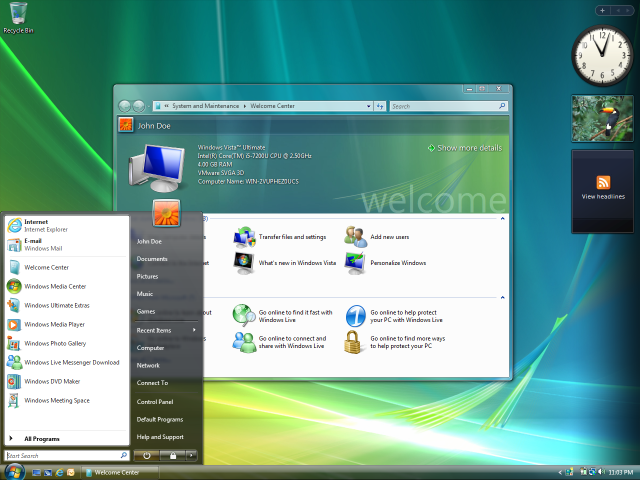Part IV: The Clash of Developers- Sinofsky vs. Allard
The release of Windows Vista, in late 2006, was wrought with controversy. Even as the operating system brought to the fore numerous improvements over Windows XP, such as a new interface in the form of Aero, the appearance of limited user profiles through User Account Control, and better support for 64-bit, the system was bogged with numerous problems. It was bloated and slow, and consumers were hesitant to upgrade from Windows XP, which had proven itself to be a rather reliable operating system throughout its life. As a result of the hesitant consumer adoption of Windows Vista, developers were also reluctant to create programs for Vista. Microsoft proved itself to have a major problem on its hands. Tech sites, such as Endgadget, bashed Vista, and Apple started a line of "Get a Mac" ads poking fun at Vista's flaws.
Windows Vista (note the new UI compared to Windows XP)
People were losing faith in Microsoft's ability to create highly popular and relevant operating systems. A successor to Vista was rapidly needed.
In the Windows team, debate raged as to what the future of Windows would be. Allard believed that mobile was the future and that desktop Windows would need to adapt itself to the increasingly mobile-dependent future. In contrast, Sinofsky argued for a slower, more methodical approach. Windows, after all, was long the domain of large corporations, who were very conservative when it came to system changes.
Both men argued fiercely over which direction Windows should take, and both sides had their own set of developers that emphasized one form of Windows over the other. A sort of civil war raged between these two different factions. Ballmer sensed that this civil war would end up hurting Microsoft more in the long run than simply bridging the gap between the two sides.
Therefore, Ballmer called Allard and Sinofsky to a meeting.
Both men were told by Ballmer that they needed to compromise. "Both of you are geniuses in your respective fields. There's really no need for either of you to argue. However, while you two waste your time arguing over minor quibbles, the Mac is gaining on us. Either get your acts together and start working as a team, or I will fire both of you. There are plenty of young developers committed to Microsoft that would love to take your place."
While neither of the two men liked each other, they realized that they had to work together. A compromise was struck between the two men: Windows 7, as the successor to Windows Vista would be called, would adopt a rolling release model. It would still have service packs, but there would be no more versions of Windows after 7. This made Allard happy, as the model was similar to the one he wanted. However, Windows 7 would be a desktop OS first and foremost, pleasing Sinofsky.
Work soon began on Windows 7. Both men were confident that they were on to a winner.
However, while the desktop may have been set on a clear trajectory, the trajectory of Microsoft's mobile efforts was still in progress.

